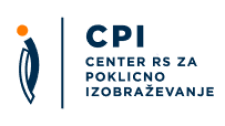Diplomirani plesalec koreograf (vs)/diplomirana plesalka koreografinja (vs)
| Name of qualification | Name of qualification: Diplomirani plesalec koreograf (vs)/diplomirana plesalka koreografinja (vs)Add to comparison |
|---|---|
| Translated title (no legal status) | Translated title: Bachelor of Applied Arts in dance and choreography |
| Type of qualification | Type of qualification: Professional bachelor's degree |
| Category of qualification | Category of qualification: Educational Qualification |
| Type of education | Type of education: Professional bachelor's education |
| Duration |
Duration of education:
3 years
|
| Credits | Credits: 180 credits |
| Admission requirements |
Entry conditions:
All candidates must pass an aptitude test and present and defend a portfolio.
|
| ISCED field |
Field:
Arts and humanities
|
| ISCED subfield | subfield: music and performing arts |
| Qualification level |
SQF Level:
SQF 7 |
- participate in various forms of creative and production-related styles of dance and choreography and at the same time develop them autonomously,
- demonstrate understanding of problem issues in dance and choreography with an emphasis on exploring and developing own interpretation, while at the same time critically and reflectively thinking about own and other choreographies,
- demonstrate proficiency in research methods and develop different creative approaches in dance and choreography, compare them to each other, analyse them and place them in narrower and broader artistic/cultural and social contexts,
- develop critical and self-critical judgement in the process of receiving information, its creative application, its realisation and its articulation in artistic creation,
- apply knowledge in practice,
- take on different roles and connect their parts with different fields (choreographic set-up, graduates understand and know how to use the space, the set, costumes, lights, music, etc.),
- demonstrate knowledge of domestic and international artistic production and the role of the media and incorporate artistic productions and reflections into the international context,
- take part in international forms of education through planned exchanges at a partner institution,
- demonstrate understanding (practical, reflective, theoretical) of the technical field of artistic, movement and dance culture from the point of view of: dance choreography performance, system of preparation of dancers, artistic genres and related professional and academic fields,
- successfully lead and manage (plan, organise, record, check, analyse, correct) dancers and the process of preparing dances at the level of tactical-mental, technical, special and basic motor and theoretical preparation, and at the level of the transformational process (educational, learning and dance aspects),
- correctly artistically evaluate and critically judge dance and the development of own dance expression and creativity,
- undertake organisational and management activities in the broader and narrower profession (art and culture sector, clubs and associations, etc.),
- demonstrate proficiency in connecting elements into a logically complete unit,
- demonstrate proficiency in basic advanced choreographic elements of dance genres with an introduction, core section and conclusion,
- realise and demonstrate ideas in relation to another, seek possibilities for the interpretation of dance material at an advanced level and demonstrate understanding of physicality through the choreographic process,
- demonstrate proficiency in the basics of choreography with regard to the number of dancers, the dancer's body, music and movement in space,
- undertake professional work in a moral and ethical manner,
- integrate the professional field of activity with the broader social environment.
Students may enrol in a higher year if by the end of the academic year they have completed all requirements defined by the study programme for progression to the next year.
Diplomirani plesalec koreograf (vs)/diplomirana plesalka koreografinja (vs)
SQF 7
EQF 6
The Career path tab shows the possible career path within the selected qualification area, which is not the only one and is not mandatory. The actual transition between qualifications, which is determined by law, is defined in the Transition tab.
SQF 8 / EQF 7
Second-cycle master's study programmes (SQF level 8)
Qualification description
Kratek opis
Koreograf, prvotno je beseda pomenila "zapisovalec gibov" (koreos-grafos, gr.), je ustvarjalec na plesnem področju. Ustvarja baletne in plesne predstave, koncerte ali posamezne točke.
Kaj delavec običajno dela
Samostojen balet lahko koreograf ustvari po lastnem scenariju in z originalno avtorsko koreografijo. Ali pa uporabi kot predlogo scenarija kakšno literarno delo, pesem, dramo in po njih uresniči svojo avtorsko gibalno- plesno vizijo. Lahko ustvari plesno predstavo brez konkretne vsebine. Tudi sodelovanje z glasbeniki je različno. S skladateljem se dogovori, da mu bo za njegov scenarij napisal originalno glasbo. Ali pa uporabi že napisano glasbo. Možne so tudi koreografije brez glasbene spremljave ali s spremljavo raznih akustičnih sredstev človeškega glasu, zlogov, besed, dihanja, raznih šumov, ropota in elektronskih zvokov. Koreograf se samostojno odloči za temo in vsebino svojega novega baleta, vendar se marsikdaj upoštevati repertoarno politiko gledališča oziroma baletnega ansambla in njegove zmogljivosti. Pa tudi finančne in tehnične možnosti, ki so na razpolago.
Že napisan scenarij pregleda in ga po potrebi predela. Odloči se za stil koreografije in izbere ustrezno zasedbo. Dogovori se tudi z umetniškimi in tehničnimi sodelavci: kostumografom, scenografom in mojstrom razsvetljave. Ko ti pripravijo osnutke, se dogovori s tehničnimi vodji glede izdelave kostumov in scene, rekvizitov, odrske tehnike in vsega, kar je potrebno za uspešno predstavitev plesnega projekta. Dogovori se z glasbenim vodjo- dirigentom o glasbenih poudarkih, tempih in o možnih zamenjavah posameznih glasbenih točk. Upravi gledališča predlaga posebne zahteve za uspešno izvedbo projekta, morebitne goste, soliste ali zboriste. V dogovoru s sodelavci pregleda finančni predračun projekta.
Poleg ustvarjalnega dela - same koreografije - skrbi za organizirano delo vseh sodelujočih. Predvideva in razpisuje termine za vaje solistov in ansambla. Skupaj z dirigentom daje navodila korepetitorju-pianistu. Če ima na razpolago baletnega repetitorja, daje navodila in zadolžitve tudi njemu. Skrbi za celoten potek priprav za projekt predvsem z umetniškega vidika. Z vodjo tehnike se dogovori o tehničnih zahtevah, problemih in njihovih rešitvah. Če je stalni, tako imenovani hišni koreograf v gledališču ali skupini, skrbi tudi za večletno repertoarno in zasedbeno politiko in s tem za umetniški razvoj posameznih plesalcev in njihovo delo v predstavah po premieri. Ker je plesna predstava odrsko delo, večinoma delo tudi režira.
To complete their studies, students must complete all course units prescribed by the study programme.
Independent higher education institution, Academy of Dance
URL
Awarding body URL:Upcoming event
International Conference: 10 years of Slovenian Qualifications Framework
International Conference: 10 years of Slovenian Qualifications Framework Brdo Congress Centre, Predoslje 39, 4000...
© Center RS za poklicno izobraževanje, 2018. All rights reserved
Sitemap General legal notice Cookie Policy Production: ENKI







